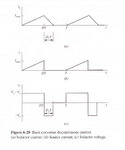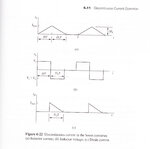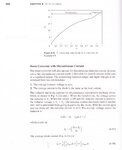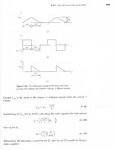jegues
Member level 3
Hello all,
I'm having some trouble figuring out the average inductor current for the Boost Converter when operating in Discontinuous Conduction Mode.
If we look at the analysis/waveforms for the Buck converter (see first figure attached) we can find the average inductor current as follows,
\[I_{L,BUCK} = \frac{\frac{1}{2}I_{max}DT + \frac{1}{2}I_{max}D_{1}T}{T} = \frac{1}{2}I_{max}(D + D_{1})\]
If I apply this same technique to the Boost converter waveforms (see second figure attached) and solve for the average inductor current I get,
\[I_{L,BOOST} = \frac{\frac{1}{2}I_{max}DT + \frac{1}{2}I_{max}D_{1}T}{T} = \frac{1}{2}I_{max}(D + D_{1})\]
but according to my text this result is incorrect. Why?
My textbook implies that,
\[I_{L,BOOST} = \frac{1}{2}I_{max}\]
which is simply the midpoint of the sloped portion of the inductor current, which is where we'd expect the average to be, but then it begs the question as to why the average inductor current for the Buck converter is,
\[I_{L,BUCK} = \frac{1}{2}I_{max}(D + D_{1}) \neq \frac{1}{2}I_{max}\]
What am I neglecting?
I'm having some trouble figuring out the average inductor current for the Boost Converter when operating in Discontinuous Conduction Mode.
If we look at the analysis/waveforms for the Buck converter (see first figure attached) we can find the average inductor current as follows,
\[I_{L,BUCK} = \frac{\frac{1}{2}I_{max}DT + \frac{1}{2}I_{max}D_{1}T}{T} = \frac{1}{2}I_{max}(D + D_{1})\]
If I apply this same technique to the Boost converter waveforms (see second figure attached) and solve for the average inductor current I get,
\[I_{L,BOOST} = \frac{\frac{1}{2}I_{max}DT + \frac{1}{2}I_{max}D_{1}T}{T} = \frac{1}{2}I_{max}(D + D_{1})\]
but according to my text this result is incorrect. Why?
My textbook implies that,
\[I_{L,BOOST} = \frac{1}{2}I_{max}\]
which is simply the midpoint of the sloped portion of the inductor current, which is where we'd expect the average to be, but then it begs the question as to why the average inductor current for the Buck converter is,
\[I_{L,BUCK} = \frac{1}{2}I_{max}(D + D_{1}) \neq \frac{1}{2}I_{max}\]
What am I neglecting?



